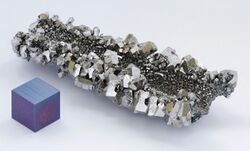Niobium, 41 Niobium Pronunciation (ny-OH -bee-əm Appearance gray metallic, bluish when oxidized Standard atomic weight A r, std (Nb) 37 (1)[1] Niobium in the periodic table
Atomic number (Z ) 41 Group group 5 Period period 5 Block d-block Element category d-block Electron configuration [Kr ] 4d4 5s1 Electrons per shell 2, 8, 18, 12, 1 Physical properties Phase at STP solid Melting point 2750 K (2477 °C, 4491 °F) Boiling point 5017 K (4744 °C, 8571 °F) Density (near r.t. ) 8.57 g/cm3 Heat of fusion 30 kJ/mol Heat of vaporization 689.9 kJ/mol Molar heat capacity 24.60 J/(mol·K) Vapor pressure
P (Pa)
1
10
100
1 k
10 k
100 k
at T (K)
2942
3207
3524
3910
4393
5013
Atomic properties Oxidation states −3, −1, 0, +1, +2, +3, +4, +5 acidic oxide) Electronegativity Pauling scale: 1.6 Ionization energies 1st: 652.1 kJ/mol 2nd: 1380 kJ/mol 3rd: 2416 kJ/mol Atomic radius empirical: 146 pm Covalent radius 164±6 pm Spectral lines of niobiumOther properties Natural occurrence primordial Crystal structure body-centered cubic (bcc) Speed of sound thin rod 3480 m/s (at 20 °C) Thermal expansion 7.3 µm/(m·K) Thermal conductivity 53.7 W/(m·K) Electrical resistivity 152 nΩ·m (at 0 °C) Magnetic ordering paramagnetic Young's modulus 105 GPa Shear modulus 38 GPa Bulk modulus 170 GPa Poisson ratio 0.40 Mohs hardness 6.0 Vickers hardness 870–1320 MPa Brinell hardness 735–2450 MPa CAS Number 7440-03-1 History Naming after Niobe in Greek mythology, daughter of Tantalus (tantalum ) Discovery Charles Hatchett (1801) First isolation Christian Wilhelm Blomstrand (1864) Recognized as a distinct element by Heinrich Rose (1844)Main isotopes of niobium
Category: Niobium view · talk · edit references
Nb
data m.p. cat
in
calc from C
diff
report
ref
C
2477
—
—
K
2750
2750
0
F
4491
4491
0
max precision
0
WD
input
C: 2477, K: 2750, F: 4491
comment
Nb
data b.p. cat
in
calc from C
diff
report
ref
C
4744
—
—
K
5017
5017
0
F
8571
8571
0
max precision
0
WD
input
C: 4744, K: 5017, F: 8571
comment
References These references will appear in the article, but this list appears only on this page.
↑ Meija, Juris; Coplen, Tyler B.; Berglund, Michael; Brand, Willi A.; De Bièvre, Paul; Gröning, Manfred; Holden, Norman E.; Irrgeher, Johanna et al . (2016). "Atomic weights of the elements 2013 (IUPAC Technical Report)". Pure and Applied Chemistry 88 (3): 265–91. doi :10.1515/pac-2015-0305 . Template:Documentation


